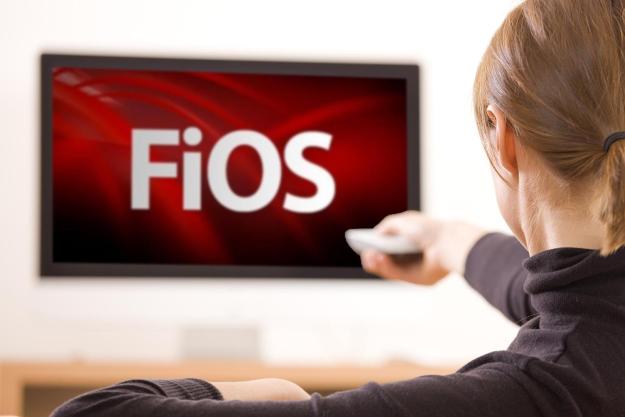
- Excellent HDR for $900
- Auto tone mapping with PS5
- Works with G-Sync and FreeSync
- Easy to use OSD and software
- KVM switch with two USB ports
- DisplayPort over USB-C and HDMI 2.1
- Vignetting around the edges
- Stand doesn't get high enough
- SDR is lacking behind VA panels
- Poor color and brightness uniformity
Next-generation consoles like the PlayStation 5 and Xbox Series X pushed a lot of gamers toward gaming monitors instead of TVs, and Sony is finally capitalizing on that trend. The InZone M9 is Sony’s first gaming monitor. It’s a $900 display that’s a perfect companion to the PS5, but it’s still among the best 4K monitors for PC due to its HDMI 2.1 support, G-Sync compatibility, and perfectly balanced HDR.
Full Array Local Dimming (FALD) takes center stage to provide an HDR image worthy of our roundup of the best monitors, but the InZone M9 offers so much more. There are features specifically tailored for the PS5, for example, and the price is too good to ignore. If you’re looking for a gaming monitor that ticks all of the boxes and then some, the InZone M9 is for you.
Sony InZone M9 specs
| Sony InZone M9 (SDM-U27M90) | |
| Screen size | 27 inches |
| Panel type | IPS |
| Resolution | 3840 x 2560 (4K) |
| Peak brightness | 600 nits |
| HDR | DisplayHDR 600 w/ Full Array Local Dimming (96 zones) |
| Response time | 1ms GtG |
| Refresh rate | 144Hz |
| Curve | None |
| Speakers | 2x 2W |
| Inputs | 2x HDMI 2.1, 1x DisplayPort 1.4, USB-C |
| USB ports | 2x USB-A, 1x USB-B |
| Adjustments | Height adjustment (2.5 inches) |
| List price | $899 |
The perfect PS5 companion
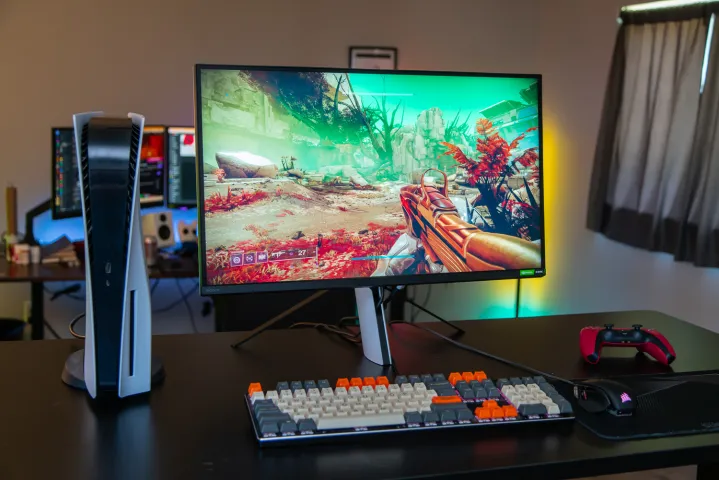
The InZone M9 looks great, especially next to a PlayStation 5. They’re purpose-built for each other, with the monitor wrapping stark white plastic around a black interior for a futuristic look. The monitor even has a glow behind it like the PS5, as well, which you can adjust to match the look of the LEDs on the console.
The stand is where things get funky though. It has three legs, unlike the standard two you find on most monitor stands. It’s certainly a unique look, and it’s a huge space saver on cramped desks.
I’m just not sure what Sony was thinking with the ergonomics here. It’s just tall enough. Even at its highest point, I couldn’t find a position where I wasn’t tilting my neck downwards. The range of height adjustment is so low, too, so there’s very little room to adjust it how you want. Unless you have a lot of room for height adjustment with your desk and chair, the InZone M9 was uncomfortable to use without a monitor arm. There’s a touch of tilt adjustment to help, but you’ll still be angling your neck down in most cases.
The ergonomics are a shame because the M9 and its stand really do look fantastic. Sony took advantage of the PS5 beyond looks, too. The M9 features an automatic genre mode that can toggle between the low-latency Game mode and quality-focused Cinema mode depending on what you’re doing on your PS5.
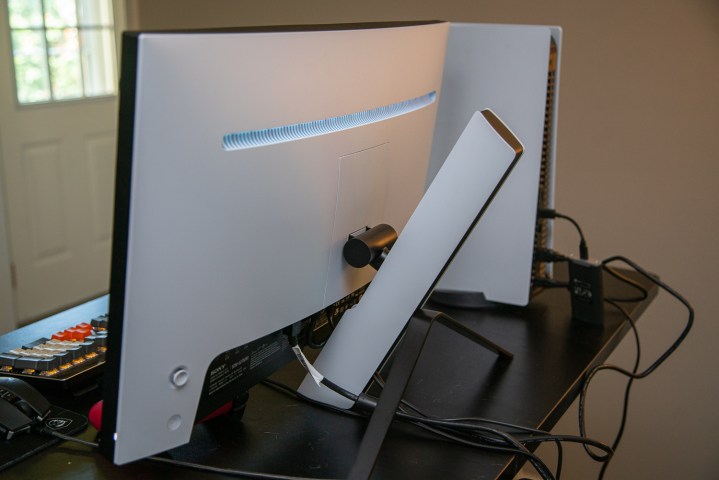
More importantly, the M9 does automatic HDR tone mapping. The PS5 can detect the M9 as the monitor, and it will adjust the color and brightness values it spits out to cater to Sony’s display. I’ll dig more into that in the performance sections below, but spoiler alert: the HDR tone mapping is really good.
Controlling the InZone M9

The M9 has a great selection of ports: two HDMI 2.1 to support 4K at 120Hz on the PS5, a single DisplayPort 1.4 connection, and even support for USB-C. You get a couple of USB ports if you hook up the USB-B connection to your PC, and thanks to the KVM switch inside the M9, you can swap your peripherals between devices just by changing the input. All thumbs up here.
What’s more exciting is the OSD. I’ve praised the menus on monitors like the Acer Predator X28, but even they don’t hold a candle to the M9. You get a large, clearly legible, and understandable OSD that’s dead simple to navigate with the joystick behind the right side of the monitor. Sony uses a separate power button, too, so you won’t accidentally switch off the display.
The InZone Hub invites a deeper level of monitor customization
You don’t have to use the OSD, though, and I recommend you don’t. The InZone Hub app gives you all of your monitor settings on your desktop, and unlike the MSI MPG32-QD, you don’t need to hook up a USB cable to use the software.
Inside, you’ll find five picture modes: Cinema, Standard, FPS, Game 1, and Game 2. The two gaming picture modes are actually custom slots where you can adjust brightness, contrast, etc. Otherwise, the picture settings are locked outside of the black equalizer and local dimming setting. None of them are bad, but the Standard mode is scorching bright, while the Cinema mode has a signature warm color temperature that only really looks good if you’re watching a moody drama.
I adjusted the brightness of the first gaming mode down to a comfortable level and went to a neutral color temperature, but that’s all I had to do to get the monitor looking how I wanted.

I suspect most people don’t configure their monitor settings because, frankly, it’s annoying dealing with an OSD and a joystick. The InZone Hub invites a deeper level of customization, which I love, and manages to provide all the crucial picture settings you need without getting into advanced color calibration that only a small fraction of people will take advantage of.
Image quality on the Sony InZone M9

I strapped my SpyderX on the M9 to verify the specs listed by Sony, and almost everything checks out. It’s a wide gamut display that covers 100% of the sRGB spectrum and 92% of DCI-P3 based on my testing. Sony says it covers 95%, but my results are close enough that I’m content. My panel was surprisingly color accurate, too, with an average Delta-E (difference from real color) of 1.14. Less than 2 is ideal for colorwork, though the M9 certainly isn’t a display for video or photo pros.
The other results are straightforward for an IPS panel. In SDR, the M9 topped out at a peak brightness of 419 nits, with a contrast ratio of 900:1. The higher 600 nit mark that Sony quotes comes with local dimming and HDR turned on, and I actually measured a much higher value of 834 nits with VESA’s DisplayHDR Test tool. That’s super bright for an IPS panel, but keep in mind that this test blasts 10,000 nits at the screen at once. It’ll rarely get that bright in use.
The HDR can outpace even the best VA panels on the market.
Native contrast isn’t going to floor you; this is an IPS panel, which universally have poorer contrast compared to VA options. It’s the HDR contrast that stands out. With HDR and local dimming on, I measured a contrast ratio of 5,180:1, which outpaces even the best VA panels.
The specs and my testing checks out, but my subjective experience with the M9 was far from perfect. My initial review unit arrived with a few panel defects — not a huge deal, these things are bound to happen to at least a few of any monitor — and Sony swiftly sent out another one free of defects apart from small vignetting.
The image quality is decent on the InZone M9, but that’s not the selling point. The HDR performance and console features make it stand out for both PS5 and PC.
Game-changing HDR performance
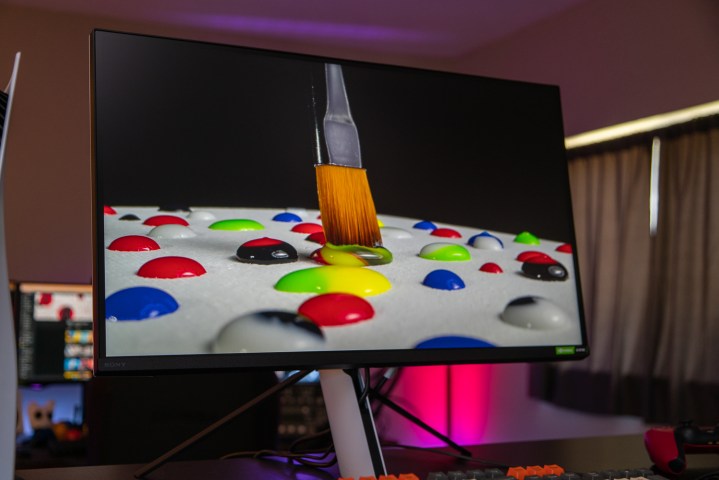
The InZone M9 is certified with VESA’s DisplayHDR 600 certification, which, as monitors like the Samsung Odyssey G7 show, doesn’t always indicate great HDR performance. For the M9, the big deal isn’t its DisplayHDR certification. It’s Full Array Local Dimming (FALD).
Unlike the Odyssey G7 and LG’s ever-popular 27GP950, which have dimming zones on the edges of the display, the InZone M9 comes with dimming zones all around the screen. And it comes with 96 zones, which compares to only eight zones on the Samsung monitor and 16 zones on LG’s. Those zones make a huge difference. Unless you seek out a QD-OLED panel like the Alienware 34 QD-OLED, you’re not going to find a better HDR experience below $1,000.
This is easily the best HDR experience you’ll get on a PC under $1,000
DT contributor Arif Bacchus actually saw the M9 right next to LG’s popular 27-inch monitor, and he didn’t mince words: “I’m telling you, the Sony is better.”
I started with Destiny 2 to test HDR performance, which has become my litmus test with its eye-scorching contrast. And it looked great. HDR monitors have been lagging behind TVs for a while, and the InZone M9 is finally raising the bar. Due to the 96 dimming zones, you get much higher contrast in games like Destiny 2 without seeing individual parts of the monitor adjust how bright they are.
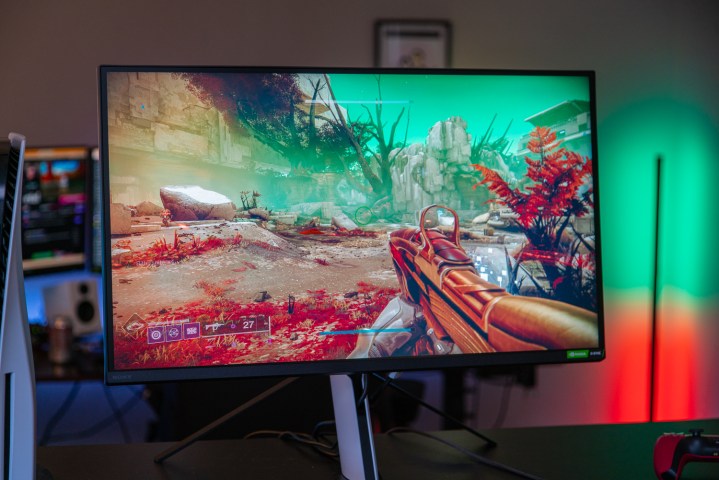
HDR gaming is great, easily the best experience on PC you’ll find for $900 (at least at this resolution). PS5 is even better due to the automatic tone mapping. I played through some of Tales of Arise and Returnal, both of which looked fantastic. Tales really shined with its watercolor-esque art, as the tone mapping and local dimming squeezed out hidden areas of contrast I never paid any mind to.
PC and PS5 gaming are nearly perfect
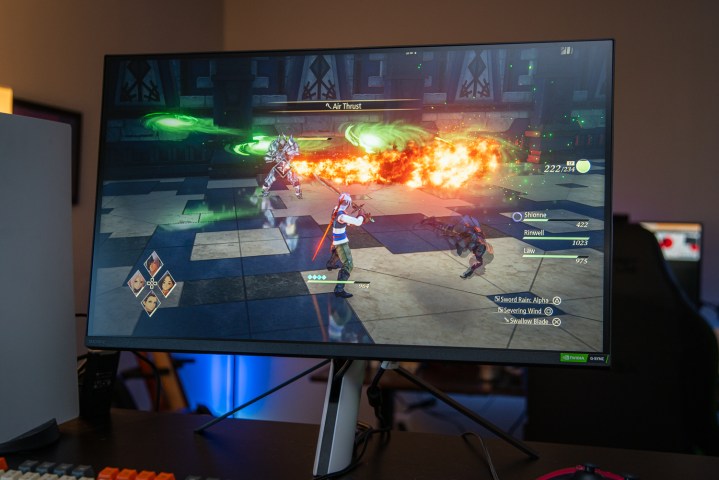
Gaming is a treat on the M9, especially if you have a PC and PS5. I had both hooked up, and I swapped back and forth between my machines instantly thanks to the deep integration the M9 has with Sony’s hardware. The console picked up the M9 right away and optimized the PS5 picture settings, and all I had to do was tickle the brightness slider to get a fantastic image. This is Sony taking advantage of its gaming ecosystem.
For raw gaming features, the monitor support variable refresh rate (VRR) and goes up to 144Hz. It’s G-Sync Compatible, which means VRR works across Nvidia and AMD GPUs, and the PS5 automatically turned on VRR in the settings once I hooked the monitor up.
I used the M9 as my primary gaming monitor for just over a week, trying everything from Destiny 2 to Tale of Arise to Neon White — whatever I happened to be playing at the time. And it’s fantastic. Even with HDR turned off, the local dimming offers a nice bump in contrast to some PC games, and the always-on HDR on the PS5 takes the local dimming nicely.
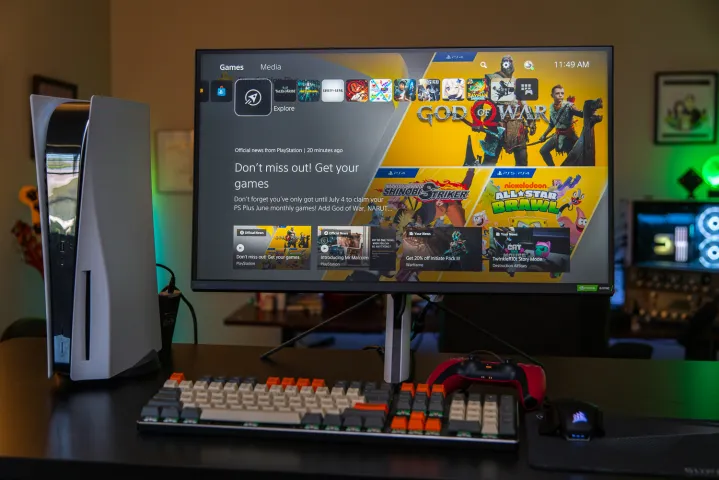
VRR support and a 144Hz refresh rate take the M9 outside of Sony’s console, too (though, you’ll need one of the best graphics cards to drive those frame rates at 4K). The only minor issue is some ghosting at high overdrive levels. The M9 allows you to lower the response time with overdrive, and as these settings typically do, there was some ghosting behind moving objects. It was far from a problem, though, and the monitor defaults to having overdrive turned off.
It all comes down to price
Price is the key factor that the M9 lives and dies by, and Sony is choosing to live. The list price is $900, which will almost certainly catapult the M9 to the go-to monitor for 4K gaming. The past few years have been dominated by two monitors around the same price — the 28-inch Samsung Odyssey G7 for $800 and the LG 27GP950 for $900 — and the M9 beat them point-for-point.
It’s finally a step forward for gaming monitors. There are at least a half dozen other 28-inch 4K monitors with a 144Hz refresh rate, but they’re all around the same price with only slight deviations in features. The Gigabyte M28U is cheaper and comes with a KVM switch, for example. The M9 stands apart with its 96-zone FALD.
My main question is how much the M9 will actually sell for. List price to list price, it’s a great deal. But the standard guard of 4K monitors around this price are frequently on sale, below $600 in a lot of cases. And in that situation, better HDR performance doesn’t quite seem worth the premium.
Our take
Panel issues aside, you can’t ignore the M9. There isn’t another monitor at this price that does everything the M9 does. It’s the best HDR monitor for gaming you can buy under $1,000 right now, and it’s even better if you can pair it with both a PC and PS5. HDR is the big selling point, though. If HDR isn’t important to you, the tried and true options from Samsung and LG offer a similar experience (and usually for less money).
Are there any alternatives?
Yes, there are several alternatives. The two main competitors are the LG 27GP950 and Samsung Odyssey G7, which are around the same price when they’re not on sale. They’re almost identical to the InZone M9, though they lack full-array local dimming.
Meanwhile, the Alienware 34 QD-OLED offers an even better HDR experience, though you’ll have to pay considerably more for it.
How long will it last?
Most IPS monitors will last at least a decade and often longer. The M9 shouldn’t be any different, though be wary of panel defects.
Should you buy it?
If you highly value HDR, yes. There isn’t another monitor offering what the M9 does at this price. If you don’t care about HDR, and especially if you’re strictly a PC gamer, the LG and Samsung alternatives offer a better value overall.
Editors' Recommendations
- PS5 vs. PC: Which is the better buy for gaming in 2024?
- Sony’s new InZone gaming headsets raise the bar for PS5 audio
- How powerful is the M1 Max’s GPU? Estimates say possibly more than a PS5
- Samsung updates Odyssey G9 gaming monitor with Quantum mini-LED tech


